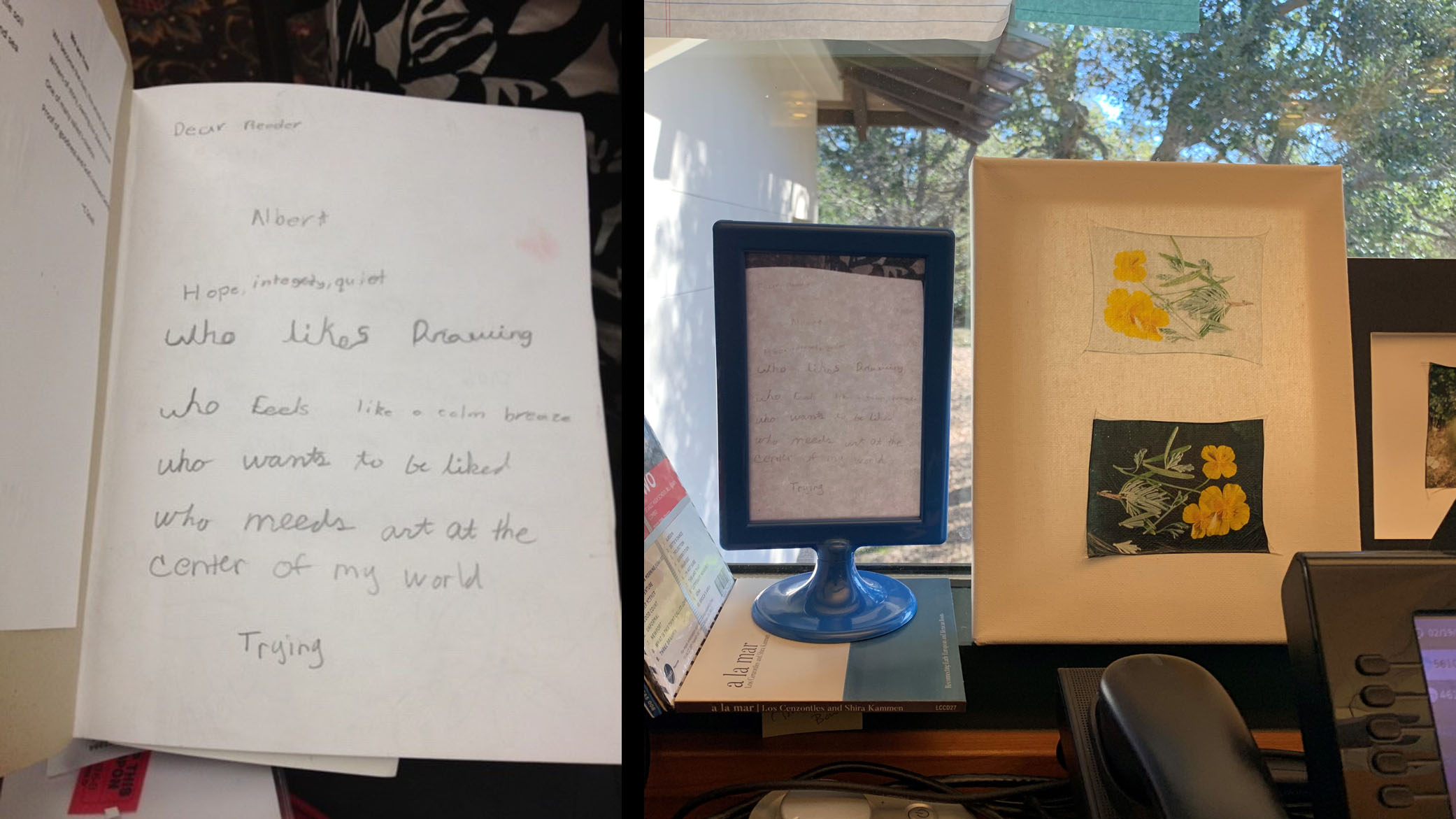Renewing our support for arts education policy and advocacy
Dear reader
Albert
Hope, integrity, quiet
who likes drawing
who feels like a calm breeze
who wants to be liked
who needs art at the center of my world
Trying
Albert’s poem found me at an arts education convening in Fresno in 2013. It was arranged in a jumble of words and paper—poetry written by Albert and his fourth grade classmates. Together, they formed a literary centerpiece in the middle of our dinner table. I snapped a photo and never forgot it. Today, that photo sits on my desk at Hewlett.
Albert’s words drive me to do this work. I know that there are many Alberts in California without art in their classroom at school; without a poet to cultivate their creativity. And they’re all trying. It’s our responsibility to help them.

The photo of a student's poem that sits on program officer Jessica Mele's desk.
The Hewlett Foundation’s Performing Arts Program has been supporting arts education organizations almost since the beginning of our grantmaking. In 2007, we began supporting policy and advocacy work in arts education with the publication of An Unfinished Canvas. That report revealed that our public education system was not meeting the requirements set out in the state’s own education code: to ensure that all public school children in California receive instruction in dance, theater, music and visual art. That fact alone was troubling. Even more troubling were the deep inequities it showed between regions, districts, and even schools in the arts education opportunities available to students.
Our support for arts education policy and advocacy and our grantees work in that area has evolved significantly since An Unfinished Canvas. As a result, we undertook an evaluation of that sub-strategy in 2017, and a “strategy refresh”—a standard practice at the Hewlett Foundation where we look closely at our grantmaking to see if it is achieving its intended goals and how it should shift in light of changed external context—of the work in 2018. Ten years later, it is clear that so much has changed: we now have a statewide coalition in support of arts education, called Create CA; we have dance and theater teaching credentials; and we have a data system to track inequities in public school availability of and enrollment in arts courses.
In addition to these changes in the landscape, our approach to policy and advocacy work in arts education has become more sophisticated over time. Originally, we saw our work in this area in terms of fostering a new generation of arts patrons and artists, which necessitated more arts education. Today, we believe kids need to receive a well-rounded education, and that must include the arts. That shift is represented by a new vision statement for our policy and advocacy work:
We envision a future in which every student’s creativity is a central resource for their own learning, motivation, self-expression, and social navigation. It is guided by teachers, artists, classroom environments, and school cultures that prioritize and trust the power of art to generate positive learning environments and engaged citizens.
The upshot is this: a lot of great things happened to change the landscape of arts education in California and nationally, many with the active help of our grantees. But so much is yet to be done. So, ten years after first deciding to take on support for arts education policy advocacy, our goal remains the same: All California students will have equitable access to high-quality, sequential arts education opportunities. While the baseline is slightly better, it is nowhere near meeting the expectation set by the California state education code. And those inequities in access, quality, and equity of arts education persist. Like many inequities in public education, they are consistently based on race, income, and geography.
In the course of examining our work in arts education policy and advocacy, we became aware of a huge blind spot: what is the state of arts education in our home region of the Bay Area? Of our 200-plus grantees across our entire Performing Arts Program portfolio working in this region, how do their programs help us achieve the goal and vision outlined in our policy and advocacy work? Our overall Performing Arts Program Strategy refresh—in process now—is the right moment to tackle these questions.
First, we needed some sense of public school access to arts education in the form of course availability and enrollment. Second, we needed to understand what impact our grantees in the rest of the portfolio are having on arts education in the Bay Area.
To that end, we commissioned two additional studies:
- Bay Area Arts Education Report: A regional version of the statewide Arts Education Data Project, this body of work shows where districts provide arts education for middle and high school students and in what art forms. Reports for each of the 11 counties in the Bay Area where the Performing Arts Program makes grants are also available. It also shows the level at which students are choosing to enroll in those courses (unfortunately, the California Department of Education does not collect data on course availability and enrollment at the elementary level, so these reports focus on grades 6-12).
- Grantee Arts Education Report: In addition to support for organizations doing arts education policy and advocacy, we directly fund 31 organizations whose mission is delivering arts education programming. Yet we know anecdotally that many of our grantees across our portfolio are working with youth, in addition to making and presenting their artistic work. A survey of our grantees shows who these organizations are, what programs they are providing, and where they are provided.
The results of these studies contained both surprises and confirmation of long-held suspicions. All of it has been valuable for our learning process as we think about how to update our grantmaking strategies. And all of it will help us align our support of arts education with our goals and vision. Because every Albert in California deserves the chance to develop his creativity, author his own future, and make sense of the world.


